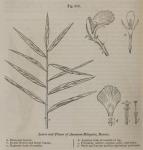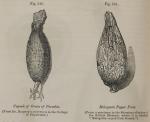![]()
 Sex, Syst. Monandria, Monogynia.
Sex, Syst. Monandria, Monogynia.
(Semina.)
History.—The term "Malagueta pepper" [This word is variously spelt Malagueta, Malaguetta, Melegueta, Mellegetta, Meligetta, &c. Several etymologies of it have been given: some say the seeds have been so called in consequence of their resemblance to Turkey millet, termed by the Italians melica or melega. Savary says the term is derived from mala gente, the designation applied by the Portuguese to the people of the coast yielding the seeds. Another derivation (suggested to me by Mr. R. Thomson, of the London Institution) is Melli (also written Melle and Mali), a kingdom of Nigritia; and gitti (or gitter), a Portuguese name for pepper. Barbut says the Portuguese word malagueta is from the native name for the pepper, emanegéta.] has been applied to the fruit or seeds of several zingiberaceous plants, [See a paper on "Grains of Paradise," by the author, in the Pharmaceutical Journal, vol. ii. p. 443, 1843.] as well as to the pimento or allspice. [See Ortega, Historia natural de la Malagueta, o Pimienta de Tavasco, Madrid, 1780.] It is usually considered to be synonymous with the terms "grains of paradise" and "Guinea grains".
Malagueta pepper is said to have been known in Italy before the discovery of the Guinea coast by the Portuguese in the 15th century. It was brought by the Moors, who used to cross the great region of Madingha and the deserts of Lybia, and carry it to Mundi Barca (or Monte da Barca), a port in the Mediterranean. The Italians, not knowing the place of its birth, as it is so precious a spice, called it grana paradisi. [De Barros, quoted in the Encyclop. Metropol, art. Guinea.]
Botany.—The botanical history of these seeds is still involved in some obscurity. Two plants, one called by Afzelius and Smith Amomum Granum Paradisi, the other termed by Roscoe A. Melegueta, have been said to produce them. But some doubt exists whether these be identical or distinct species. In 1847, in a paper [Pharmaceutical Journal, vol. vi. p. 412, 1847.] on Roscoe's A. Melegueta, I mentioned that there were slight differences in the appearance of the seeds of the two plants. Since then, I have ascertained that there are two sorts of grains of paradise in the market, and that these are brought from different parts of the African coast, are readily distinguished from each other in trade, and are of unequal commercial value: one of those is identical with the seeds of A. Granum Paradisi of Afzelius and Smith, the other with those of A. Melegueta of Roscoe.
1. A. Granum Paradisi, Afzelius, Remed. Guineens. x. n. 1; Nees, Offic. Pflanzen (fig.); A. Grana-Paradisi, Smith, Rees's Cyclopaed. vol. xxiii. art. Mellegetta, and vol. xxxix, suppl. art. Amomum.—Guinea coast, about Sierra Leone.
Rhizome perennial, woody, creeping horizontally. Stems erect, simple, slender, three feet high, leafy, but destitute of flowers. Leaves numerous, crowded, two-ranked, alternate, a span long and an inch broad, lanceolate, or slightly ovate, with a long taper point, entire, smooth, single-ribbed, striated with innumerable oblique veins. Their flavour is slightly aromatic, after having been dried 20 years. Foot-stalks sheathing, linear, very long, smooth, striated. Flower-stalks radical, solitary, an inch or two in length, ascending, clothed with numerous, close, sheathing bracts, all abrupt, ribbed, somewhat hairy and fringed; the lower ones very short; the upper gradually much larger. Of the parts of the flower nothing could be made out in Sir J. Smith's specimens.
[According to Afzelius, the flowers are large and white, and formed like those of A. exscapum, Sims.] Capsule an inch and a half long, half an inch in diameter, oblong, bluntly triangular, scarcely ovale, beaked, of a dark reddish brown, ribbed, coriaceous, rough, with minute deciduous bristly hairs. When broken, it is very powerfully aromatic, even after being kept 20 years, with a peculiar pepper-like flavour, rather too strong to be agreeable. Seeds numerous, enveloped in membranes formed of the dried pulp, roundish or somewhat angular, of a shining golden brown, minutely rough or granulated, extremely hot and acrid (Smith).
2. A. Melegueta, Roscoe, Monandrian Plants, 1828; Pereira, Pharm. Journ., vol. vi. p. 412, 1847.—Cultivated at Demerara: probably from Africa.
Stem erect, six feet high. Leaves two-ranked, subsessile, narrow-lanceolate. Scape radical, covered at the base with about seven imbricated, ovate, concave, pointed, and somewhat cuspidate bracts. Calyx cylindrical, of one leaf, green, spotted with red. Flowers cylindrical, expanding in a double border; outer border in three sections, the middle section largest, ovate, the two others linear and opposite; inner lip very large, broad-ovate, crenate, pale yellow at the base, crimson at the margin. Filament strong, erect, clavate, terminating in three lobes, middle lobe erect and bifid, the other two pointed and recurved; a pair of hornlets on the filament, near the base of the lip. Anther in two lobes, seated in front of the filament, a little below the apex, bright yellow. Style erect, tubular, expanding into a dilated stigma or cup, supported at the base by two linear processes, about an inch in length, and one-eighth of an inch in breadth, by much the largest specimen of this part observable in any scitamineous plant.
Capsule cylindrical, coriaceous, six inches long, yellow, spotted with orange, supported at the base by the large ovate, concave, cuspidate bracts, and containing a columella or receptacle about four inches long, covered with seeds beautifully arranged, arilled, and imbedded in a tomentose substance. Seeds angular, light brown, with a highly aromatic and grateful flavour (Roscoe).

 Description. α. Of the dried fruits.—I have met with two kinds of dried fruits whose seeds bear the name of grains of paradise or Guinea grains.
Description. α. Of the dried fruits.—I have met with two kinds of dried fruits whose seeds bear the name of grains of paradise or Guinea grains.
1. Grains of Paradise Fruit (Fig. 240).—These are oval or oval-oblong capsules, somewhat reddish-brown, and wrinkled longitudinally. Their length (exclusive of stalk and beak) rarely exceeds 1 ½ inches; and their diameter is about ½ an inch. The seeds agree with the grains of paradise brought from Cape Palmas and Sierra Leone. I am indebted to Dr. Daniell for specimens gathered from the high lands on the right of the River Congo. Some of them are strung on a cord; the usual form in which they are sold in Africa.—These fruits appear to me to agree with the Grain of Paradise Amomum described by Afzelius and Smith.
2. Malagueta Pepper Fruit (Fig. 241).—These fruits are larger than the preceding, and more ovate. Exclusive of beak and stalk they are two inches long, and one inch in diameter. They are ovate or ovate-oblong, coriaceous, wrinkled as if shrivelled, yellowish-brown. The seeds are identical with those sold in the shops as grains of paradise or Guinea grains. From the large size of this fruit, I suspect it may be the produce of Roscoe's A. Melegueta.
β. Of the seeds.—The seeds, called in the shops grains of paradise (grana paradisi) or Guinea grains (grana guineensia), are roundish or ovate, frequently bluntly angular, and somewhat cuneiform; shining golden brown; minutely rough, from small warts and wrinkles; internally white. Their taste is aromatic, and vehemently hot or peppery: when crushed and rubbed between the fingers, their odour is feebly aromatic. Their greatest diameter rarely exceeds 1 ¼ line. The acrid taste resides in the seed coats.
Two sorts are distinguished by the importers:—
1. Guinea grains from Acra.—These are somewhat larger, plumper, and more warty than the ordinary sort. On the umbilicus of the seeds there is a short, conical, projecting tuft of pale-coloured fibres. This sort fetches a somewhat higher price than the next sort. The seeds agree precisely in appearance with those obtained from Roscoe's A. Melegueta.
2. Guinea grains from Cape Palmas and Sierra Leone.—Smaller and smoother than the preceding. They are devoid of the projecting fibrous tuft on the umbilicus. Being somewhat cheaper than the foregoing sort, they form the ordinary grains of paradise of the shops. They are perhaps the produce of Afzelius and Smith's A. Granum Paradisi.
Commerce.—Grains of paradise are imported in casks, barrels, and puncheons, from the coast of Guinea. The quantities on which duty was paid during six years are as follows (Trade List):—
| In 1835 | 14603 lbs. |
| In 1836 | 16231 lbs. |
| In 1837 | 17134 lbs. |
| In 1838 | 16199 lbs. |
| In 1839 | 19036 lbs. |
| In 1840 | 9916 lbs. |
"Extract or preparation of Guinea grains" was formerly imported. [Frewin, Digested Abridgment of the Laws of the Customs, 1819.]
The heavy duty formerly imposed on grains of paradise was intended to act as a prohibition of their use. [Fourth Report of the African Institution, p. 16.]
Composition.—Grains of paradise were analyzed in 1811 by Willert, [Trommsdorff's Journ. xx. St. 2, 1811.] who obtained the following results: Volatile oil 0.52, acrid resin 3.40, extractive 1.27, tragacanthin and woody fibre 82.8 [? water and loss 12.01].
1. The Volatile Oil has a light yellow colour, a camphoraceous smell, and a hot penetrating taste.
2. The Resin is brown, soft, odourless, and has an acrid burning taste.
Physiological Effects.—Analogous to those of pepper. A very erroneous notion prevails that these seeds are highly injurious. [Roscoe, op. cit.]
Uses.—Rarely employed as an aromatic. Esteemed in Africa as the most wholesome of spices, and generally used by the natives to season their food. [Fourth Report of the African Institution.]
Its principal consumption is in veterinary medicine, and to give an artificial strength to spirits, wine, beer, and vinegar.
By 56 Geo. III. c 58, no brewer or dealer in beer shall have in his possession or use grains of paradise, under a penalty of £200 for each offence: and no druggist shall sell it to a brewer, under a penalty of £500 for each offence.

